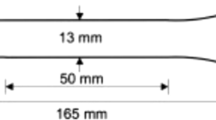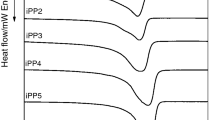Abstract
Experimental data are reported on isotactic polypropylene in uniaxial cyclic tensile tests with various maximum strains at room temperature. It is demonstrated that polypropylene reveals all characteristic features (hysteresis of energy, damage accumulation, and strain-hardening) of the Mullins effect. Constitutive equations are derived for the viscoplastic behavior of semicrystalline polymers at three-dimensional deformations with small strains. Adjustable parameters in the stress–strain relations are found by fitting the observations. Numerical simulation shows that the model adequately predicts the viscoplastic response of polypropylene in uniaxial and biaxial cyclic tests.
Similar content being viewed by others
References
Mullins L (1947) Effect of stretching on the properties of rubber. J Rubber Res 16:275–289
Mullins L (1969) Softening of rubber by deformation. Rubber Chem Technol 42:339–362
Diani J, Fayolle B, Gilormini P (2009) A review on the Mullins effect. Eur Polym J 45:601–612
Bueche F (1961) Mullins effect and rubber–filler interaction. J Appl Polym Sci 5:271–281
Hanson DE, Hawley M, Houlton R, Chitanvis K, Rae P, Orler EB, Wrobleski DA (2005) Stress softening experiments in silica-filled polydimethylsiloxane provide insight into a mechanism for the Mullins effect. Polymer 46:10989–10995
Coquelle E, Bossis G (2006) Mullins effect in elastomers filled with particles aligned by a magnetic field. Int J Solids Struct 43:7659–7672
Cheng M, Chen W (2003) Experimental investigation of the stress-stretch behavior of EPDM rubber with loading rate effects. Int J Solids Struct 40:4749–4768
Merabia S, Sotta P, Long DR (2008) A microscopic model for the reinforcement and the nonlinear behavior of filled elastomers and thermoplastic elastomers (Payne and Mullins effects). Macromolecules 41:8252–8266
Drozdov AD (2009) Mullins’ effect in thermoplastic elastomers: experiments and modeling. Mech Res Commun 36:437–443
Franceschini G, Bigoni D, Regitnig P, Holzapfel GA (2006) Brain tissue deforms similarly to filled elastomers and follows consolidation theory. J Mech Phys Solids 54:2592–2620
Ciarletta P, Dario P, Micera S (2008) Pseudo-hyperelastic model of tendon hysteresis from adaptive recruitment of collagen type I fibrils. Biomaterials 29:764–770
Webber RE, Creton C, Brown HR, Gong JP (2007) Large strain hysteresis and Mullins effect of tough double-network hydrogels. Macromolecules 40:2919–2927
Wilde TP, McDowell DL, Jacob KI, Aneja AP (2006) A modified Mullins model for compressive behavior of goose down fiber assemblies. Mech Adv Mater Struct 13:83–93
Meunier L, Chagnon G, Favier D, Orgeas L, Vacher P (2008) Mechanical experimental characterisation and numerical modelling of an unfilled silicone rubber. Polym Test 27:765–777
Ogden RW, Roxburgh DG (1999) A pseudo-elastic model for the Mullins effect in filled rubber. Proc R Soc A 455:2861–2877
Drozdov AD, Dorfmann A (2001) Stress-strain relations in finite viscoelastoplasticity of rigid-rod networks: applications to the Mullins effect. Continuum Mech Thermodyn 13:183–205
Elias-Zuniga A, Beatty MF (2003) Stress-softening effects in the transverse vibration of a non-Gaussian rubber string. Meccanica 38:419–433
Chagnon G, Verron E, Gornet L, Marckmann G, Charrier P (2004) On the relevance of continuum damage mechanics as applied to the Mullins effect in elastomers. J Mech Phys Solids 52:1627–1650
Horgan CO, Ogden RW, Saccomandi G (2004) A theory of stress softening of elastomers based on finite chain extensibility. Proc R Soc A 460:1737–1754
Göktepe S, Miehe C (2005) A micro-macro approach to rubber-like materials. Part III: the micro-sphere model of anisotropic Mullins-type damage. J Mech Phys Solids 53:2259–2283
Chagnon G, Verron E, Marckmann G, Gornet L (2006) Development of new constitutive equations for the Mullins effect in rubber using the network alteration theory. Int J Solids Struct 43:6817–6831
De Tommasi D, Puglisi G, Saccomandi G (2006) A micromechanics–based model for the Mullins effect. J Rheol 50:495–512
Meissner B, Matejka L (2006) A structure-based constitutive equation for filler-reinforced rubber-like networks and for the description of the Mullins effect. Polymer 47:7997–8012
D’Ambrosio P, De Tommasi D, Ferri D, Puglisi G (2008) A phenomenological model for healing and hysteresis in rubber-like materials. Int J Eng Sci 46:293–305
Li J, Mayau D, Lagarrigue V (2008) A constitutive model dealing with damage due to cavity growth and the Mullins effect in rubber-like materials under triaxial loading. J Mech Phys Solids 56:953–973
Aboudi J (2009) Finite strain micromechanical analysis of rubber-like matrix composites incorporating the Mullins damage effect. Int J Damage Mech 18:5–29
Cantournet S, Desmorat R, Besson J (2009) Mullins effect and cyclic stress softening of filled elastomers by internal sliding and friction thermodynamics model. Int J Solids Struct 46:2255–2264
Drozdov AD (1999) Viscoelastoplasticity of rubbery polymers at finite strains. Meccanica 34:85–102
Xia Z, Shen X, Ellyin F (2005) An assessment of nonlinearly viscoelastic constitutive models for cyclic loading: the effect of a general loading/unloading rule. Mech Time-Depend Mater 9:281–300
Yakimets I, Lai D, Guigon M (2007) Model to predict the viscoelastic response of a semi-crystalline polymer under complex cyclic mechanical loading and unloading conditions. Mech Time-Depend Mater 11:47–60
Johnson MA, Beatty MF (1993) A constitutive equation for the Mullins effect in stress controlled uniaxial extension experiments. Continuum Mech Thermodyn 5:301–318
Govindjee S, Simo JC (1992) Mullins effect and the strain amplitude dependence of the storage modulus. Int J Solids Struct 29:1737–1751
Itskov M, Haberstroh E, Ehret AE, Vöhringer MC (2006) Experimental observation of the deformation induced anisotropy of the Mullins effect in rubber. KGK Kautschuk Gummi Kunststoffe 59:93–96
Drozdov AD, de Christiansen JC (2003) The effect of annealing on the elastoplastic response of isotactic polypropylene. Eur Polym J 39:21–31
Samios D, Tokumoto S, Denardin ELG (2005) Large plastic deformation of isotactic poly(propylene) (iPP) evaluated by WAXD techniques. Macromol Symp 229:179–187
Machado G, Kinast EJ, Scholten JD, Thompson A, Vargas TD, Teixeira SR, Samios D (2009) Morphological and crystalline studies of isotactic polypropylene plastically deformed and evaluated by small-angle X-ray scattering, scanning electron microscopy and X-ray diffraction. Eur Polym J 45:700–713
Hiss R, Hobeika S, Lynn C, Strobl G (1999) Network stretching, slip processes, and fragmentation of crystallites during uniaxial drawing of polyethylene and related copolymers. A comparative study. Macromolecules 32:4390–4403
Nitta K-H, Takayanagi M (1999) Role of tie molecules in the yielding deformation of isotactic polyprolylene. J Polym Sci B: Polym Phys 37:357–368
Kolarik J, Pegoretti A (2006) Non-linear tensile creep of polypropylene: time-strain superposition and creep prediction. Polymer 47:346–356
Author information
Authors and Affiliations
Corresponding author
Rights and permissions
About this article
Cite this article
Drozdov, A.D., Christiansen, J.d. Mullins’ effect in semicrystalline polymers: experiments and modeling. Meccanica 46, 359–370 (2011). https://doi.org/10.1007/s11012-010-9314-z
Received:
Accepted:
Published:
Issue Date:
DOI: https://doi.org/10.1007/s11012-010-9314-z




